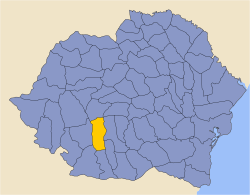Vâlcea County
County of Romania From Wikipedia, the free encyclopedia
County of Romania From Wikipedia, the free encyclopedia
Vâlcea County (also spelt Vîlcea; Romanian pronunciation: [ˈvɨlt͡ʃe̯a]) is a county (județ) that lies in south-central Romania. Located in the historical regions of Oltenia and Muntenia (which are separated by the Olt River), it is also part of the wider Wallachia region. Its capital city is Râmnicu Vâlcea.
Vâlcea County
Județul Vâlcea | |
|---|---|
 | |
| Coordinates: 45.08°N 24.11°E | |
| Country | Romania |
| Development region | Sud-Vest |
| Historical region | Muntenia, Oltenia |
| Capital | Râmnicu Vâlcea |
| Government | |
| • President of the County Board | Constantin Rădulescu (PSD) |
| • Prefect | Mihai Oprea |
| Area | |
| • Total | 5,765 km2 (2,226 sq mi) |
| • Rank | 20th |
| Population (2021-12-01)[1] | |
| • Total | 341,861 |
| • Rank | 26th |
| • Density | 59/km2 (150/sq mi) |
| Telephone code | (+40) 250 or (+40) 350[2] |
| ISO 3166 code | RO-VL |
| GDP (nominal) | US$ 2.436 billion (2015) |
| GDP per capita | US$ 6,855 (2015) |
| Website | County Council County Prefecture |
In 2011, it had a population of 355,320 and the population density was 61.63/km2.
| Year | County population[4] |
|---|---|
| 1948 | 341,590 |
| 1956 | 362,356 |
| 1966 | 368,779 |
| 1977 | 414,241 |
| 1992 | 436,298 |
| 2002 | 413,247 |
| 2011 | 355,320 |
| 2021 | 341,861 |
This county has a total area of 5,765 km2 (2,226 sq mi).
The North side of the county is occupied by the mountains from the Southern Carpathians group: the Făgăraș Mountains in the east with heights over 2,200 m (7,200 ft), and the Lotru Mountains in the west with heights over 2,000 m (6,600 ft). They are separated by the Olt River valley — the most accessible passage between Transylvania and Muntenia. Along the Olt River valley there are smaller groups of mountains, the most spectacular being the Cozia Mountains.
Towards the South, the heights decrease, passing through the sub-carpathian hills to a high plain in the West side of the Wallachian Plain.
The main river is the Olt River crossing the county from North to South. Its main affluents are the Lotru River in the North and the Olteț River in the South.
The predominant industries in the county are:
In the West of the county coal and salt are extracted.
The area in the center of the county is well suited for fruit orchards, vineyards, and raising cattle. The South is better suited for growing cereals and vegetables.
The main tourist destinations are:
The Vâlcea County Council, renewed at the 2020 Romanian local elections, consists of 32 counsellors, with the following party composition:[5]
| Party | Seats | Current County Council | ||||||||||||||||
|---|---|---|---|---|---|---|---|---|---|---|---|---|---|---|---|---|---|---|
| Social Democratic Party (PSD) | 16 | |||||||||||||||||
| National Liberal Party (PNL) | 13 | |||||||||||||||||
| Ecologist Party of Romania (PER) | 3 | |||||||||||||||||


Vâlcea County has two municipalities, nine towns and 78 communes as follows:
Județul Vâlcea | |
|---|---|
County (Județ) | |
 The building of the Vâlcea County court from the interwar period, now the Râmnicu Vâlcea court. | |
 | |
| Country | Kingdom of Romania |
| Historic region | Oltenia |
| Capital city (Reședință de județ) | Râmnicu Vâlcea |
| Area | |
| • Total | 4,081 km2 (1,576 sq mi) |
| Population (1930) | |
| • Total | 246,659 |
| • Density | 60/km2 (160/sq mi) |
| Time zone | UTC+2 (EET) |
| • Summer (DST) | UTC+3 (EEST) |
Historically, the county was located in the southwestern part of Greater Romania, in the northeast part of the historical region of Oltenia. Its capital was Râmnicu Vâlcea. The interwar county territory comprised a large part of the current Vâlcea County; however the territories situated to the east of the Olt River in the current county were not part of the historical county.
The county was bordered to the north by Sibiu County, to the east by the counties of Argeș and Olt, to the south by Romanați County, and to the west by the counties of Dolj and Gorj.

The county was in 1930 divided into five administrative districts (plăși):[6]
By 1938, there were six districts, four previous and two new ones resulting from the reorganisation of the southwest part of the county:[7]
According to the 1930 census data, the county population was 246,713 inhabitants, ethnically divided as follows: 97.4% Romanians, 1.6% Romanies, 0.2% Germans, 0.2% Hungarians, 0.2% Jews, as well as other minorities. From the religious point of view, the population was 99.0% Eastern Orthodox, 0.4% Roman Catholic, 0.2% Jewish, as well as other minorities.
In 1930, the county's urban population was 31,909 inhabitants, comprising 94.8% Romanians, 1.3% Romanies, 1.0% Germans, 0.8% Jews, 0.7% Hungarians, as well as other minorities. From the religious point of view, the urban population was composed of 96.4% Eastern Orthodox, 1.4% Roman Catholic, 0.8% Jewish, 0.7% Lutheran, 0.3% Greek Catholic, as well as other minorities.
Seamless Wikipedia browsing. On steroids.
Every time you click a link to Wikipedia, Wiktionary or Wikiquote in your browser's search results, it will show the modern Wikiwand interface.
Wikiwand extension is a five stars, simple, with minimum permission required to keep your browsing private, safe and transparent.